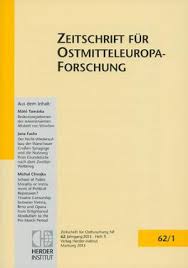Grenzgesellschaft und mehrfache Loyalitäten. Die brandenburg-preußisch-polnische Grenze 1656-1772
Border society and multiple loyalties. The Brandenburg-Prussian-Polish border 1656-1772
Author(s): Hans-Jürgen BömelburgSubject(s): Diplomatic history, Military history, Political history, 17th Century, 18th Century
Published by: Verlag Herder-Institut
Keywords: Border society; multiple loyalties; Brandenburg-Prussian-Polish border; 1656-1772;
Summary/Abstract: With a length of 1,500 km, the Brandenburg-Prussian-Polish-Lithuanian border generated border societies which took benefit of scopes in economic, denominational and political matters and developed multiple loyalties. This will be examined with regard to the micro regions of Lauenburg and Bütow, the Draheim and the Crone district. Varying lords and vassals opened up chances for appeal. In practice, throughout the early modern era, the border zones only partially evolved into a fixed boundary. By the 17th century, there were still disputes over the status of new settlements, and local conflicts were fought out by means of border violations, or even armed inroads. In Lauenburg and Bütow, Brandenburg-Prussia abandoned land registers and contributions in favour of flat rates in order to avoid protest. In Draheim, a border register was drawn up in 1687 and a general map produced in 1711, which, however, out of consideration for the neighbouring nobles, was not used for the purpose of border codification. Thus, the border line was not settled until 1798. Within the border society, there is evidence of multiple loyalties among the noble elites, who sought to combine Berlin’s and Warsaw’s goals with their own interests. This becomes obvious if we look at the examples of the Przebendowski al Lauenburg and Bütow, and at the von der Goltz in the Crone district, whose international careers were based on the situation at the border: The Przebendowski made their careers as representatives of the local nobility, as lobbyists in Warsaw and as representatives of the Protestant interests in Poland-Lithuania, which, after 1700, led them into the highest public offices. The von der Goltz belonged to the military and diplomatic elites and were leaders of the “dissidents”; their importance reached its climax between 1764 and 1795. The two families and other groups took advantage of the border society and tried to stabilize this situation, since it offered numerous opportunities for income and careers. Historiographically, these mixed loyalties have so far been overlooked and denounced as (denominational, national) “treason”; however, they are important, since they concern considerable groups within the contact zone. A history from the perspective of these groups still needs to be written.
Journal: Zeitschrift für Ostmitteleuropa-Forschung
- Issue Year: 55/2006
- Issue No: 1
- Page Range: 56-78
- Page Count: 23
- Language: German

